Signing the Treaty of Waitangi in the Auckland area
On
6 February 1840 the Treaty of Waitangi was signed in the Bay of Islands.
Lieutenant-Governor William Hobson afterwards circulated copies of the treaty
for signature by other chiefs throughout New Zealand. Over the next few
months five or six treaty meetings were held in the Waitemata and Manukau
areas.
 |
| Ref: 4-1351, William Hobson, Sir George Grey Special Collections |
The
first of these was held during Hobson’s first visit to the Waitemata, on 4
March 1840. The exact location is uncertain, but was probably Karaka Bay,
and if not Karaka Bay then certainly somewhere along the shoreline
between the Tamaki
River and Maraetai.
Sixteen Ngāti Paoa, Ngāti Maru and Ngāti Tamaterā – and perhaps also Ngai Tai –
chiefs signed a copy on this occasion, with Captain Joseph Nias and the
missionaries Henry Williams and William Fairburn acting as witnesses.
 |
| Ref:4-1062, depiction of the signing of the Treaty of Waitangi, Karaka Bay, 1840, Sir George Grey Special Collections |
Later in
the month Captain W.C. Symonds was commissioned to seek further signatures in
the Manukau area. With help from the CMS missionary James Hamlin, he organised
two meetings on the Manukau
Peninsula. These were
held in the vicinity of Awhitu, perhaps at Orua Bay.
At the first meeting the organizers failed to gain any signatures. At the
second, on 20 March 1840, although several chiefs again refused to sign, Apihai Te Kawau and two other Ngati Whatua chiefs did so. The Waikato
chief Te Wherowhero may have been present at these meetings. This copy of the
treaty is today known as the Manukau-Kawhia copy.
The
above-mentioned copies of the treaty were in Māori. An English copy of the
treaty was sent to the Reverend Robert Maunsell at his mission station at
Maraetai, near the mouth of the Waikato
River (today’s Port
Waikato). On or around 11 April 1840 a total of 32 chiefs signed this, the
so-called Waikato-Manukau copy, including several Ngāti Te Ata, Ngāti Pou and
Ngāti Tipa chiefs.
 |
| Ref: 4-JDR8129-1, Robert Maunsell, Sir George Grey Special Collections |
On 26
April 1840 a further seven further chiefs signed the same copy at another
meeting organised by Symonds,
at a location usually described as ‘somewhere on the Manukau’.
On 9
July 1840, while Hobson was on his second expedition to the Waitemata, a
further meeting was held on the shores of the Tamaki River.
Again, the exact location is uncertain, but
is generally thought to be Karaka
Bay. Seven chiefs signed
the treaty on this occasion, including Kupenga of Whakatiwai. This was the last
treaty meeting held in the region.
 |
| Ref: 7-A1747, Achilles Point to Karaka Bay is shown on the left, Sir George Grey Special Collections |
In some
accounts the treaty meeting of 4 March 1840 has been confused with that of 9
July 1840. A memorial unveiled at Karaka
Bay on 4 March 1953 thus listed
only the chiefs who had signed on the first date.
Author: Bruce Ringer, South Auckland Research Centre
Kia ora Bruce,
ReplyDeleteThanks for preparing this information. It is a great resource - succint, relevant and very user-friendly. As a descendant of various rangatira that signed the Treaty at Karaka Bay, this is by far the quickest way to obtain links to this information. We'd love to include this in our treaty events toolkit for 2014.
Ngā mihi, nā
Anahera Sadler